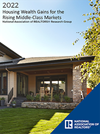Association Veteran Marty Nash Appointed HGAR Interim CEO
Nash has more than 20 years of experience in the Realtor association industry.

WASHINGTON—Homeownership is widely recognized as the leading source of net worth among families. Housing wealth itself is primarily achieved by price appreciation gains, and the nation has seen home prices accelerate at a record pace during the course of the last decade, according to a National Association of Realtors study released on March 9.
The new study entitled “Housing Wealth Gains for the Rising Middle-Class Markets” examines the distribution of housing wealth between 2010 and 2020 across income groups and in 917 metropolitan or micropolitan areas.
NAR found that during those 10 years, nearly 980,000 middle-income households became homeowners. Within that timeframe, total housing wealth for this income group surged by $2.1 trillion.
“Owning a home continues to be a proven method for building long-term wealth,” said Lawrence Yun, NAR chief economist. “Home values generally grow over time, so homeowners begin the wealth-building process as soon as they make a down payment and move to pay down their mortgage.”
The study produced mixed results for the New York City metro region. On the one hand it was among a small percentage of U.S. markets that recorded a decrease in middle-income homeowner households over the past decade. The study noted that the New York-Newark-Jersey City was the top market in the United States for losing middle-class households, having lost 100,214 middle-income households over the 10-year period. However, the New York metro area saw housing wealth rise due to rising home prices, by $59.4 billion from 2010-2020.
From 2010 through 2020, 529 of 917, or 58%, of metropolitan and micropolitan areas gained middle-income homeowners. NAR identifies these locations as rising middle-income class housing markets, i.e., markets that saw the largest increase in middle-class owner-occupied housing units in 2020 compared to 2010.
The top 10 rising middle-income housing markets, with at least 50,000 more middle-income homeowner households, were Phoenix-Mesa-Scottsdale, AZ (103,690), Austin-Round Rock, TX (61,323), Nashville-Davidson-Murfreesboro-Franklin, TN (55,252), Dallas-Fort Worth-Arlington, TX (53,421), Houston-The Woodlands-Sugarland, TX (52,716), Atlanta-Sandy Springs-Roswell, GA (48,819), Orlando-Kissimmee-Sanford, FL (35,063), Portland-Vancouver-Hillsboro, WA (34,373), Seattle-Tacoma-Bellevue, WA (31,284) and Tampa-St. Petersburg-Clearwater, FL (28,979). NAR defines a middle-class homeowner as one earning an income of over 80% to 200% of the area median income.
“Middle-income households in these growing markets have seen phenomenal gains in price appreciation,” said Yun. “Given the rapid migration and robust job growth in these areas, I expect these markets to continue to see impressive price gains.”
As of the fourth quarter of 2021, the largest price gains (as a percent of the purchase price) over the preceding decade were in Phoenix-Mesa-Scottsdale, AZ (275.3%), Atlanta-Sandy Springs, GA (274.7%), Las Vegas-Henderson-Paradise, NV(251.7%), Cape Coral-Fort Myers, FL (233.9%) and Riverside-San Bernardino-Ontario, CA (207.6%).
Nationally, a homeowner who purchased a typical single-family existing home 10 years ago at the median sales price of $162,600 is likely to have accumulated $229,400 in housing wealth. Of this wealth gain, 86% can be attributed to price appreciation, with the median single-family existing-home sales price rising at an annual pace of 8.3% from the fourth quarter of 2011 through the fourth quarter of 2021.
A small percentage of U.S. markets did record a decrease in middle-income homeowner households over the past decade, including New York-Newark-Jersey City (-100,214), Los Angeles-Long Beach-Anaheim (-73,839), Chicago-Naperville-Elgin (-34,420), Boston-Cambridge-Newton (-28,953), Detroit-Warren-Dearborn (-25,405) and Philadelphia-Camden-Wilmington (-22,129). Nevertheless, some markets saw housing wealth rise as home prices climbed, such as the Los Angeles metro area ($164.5 billion) and the New York metro area ($59.4 billion).
“These escalating home values were no doubt beneficial to homeowners and home sellers,” said Yun. “However, as these markets flourish, middle-income wage earners face increasingly difficult affordability issues and are regrettably being priced out of the home-buying process.”
While housing wealth grew among all income groups, low- and middle-income households ultimately received a smaller share of the gains. NAR found that of the $8.2 trillion amassed in housing wealth from 2010 through 2020, high-income homeowners claimed roughly 71% of all wealth accumulation. Among middle-income homeowners, total housing wealth jumped by $2.1 trillion, or 26% of the housing wealth gains, with nearly 980,000 additional middle-income homeowner households. Among low-income homeowners, housing wealth rose by $296 billion, or 4% of the housing wealth gain.
Low-income homeowners comprised a smaller fraction of all homeowners in 2020, at just 27.2%. This is down from 38.1% in 2010, with nearly 5.8 million fewer lower-income households that were homeowners from 2010 through 2020. There were 979,143 more middle-income homeowners over this decade, but they consisted of a smaller fraction of homeowners in 2020, at 43%, from 45.5% in 2010. High-income homeowners made up a larger portion of owners, at 29.8%. This is an increase from 16.4% in 2010 and is 11.1 million more high-income households in 2020 compared to 2010.
Since the Great Recession, the homeownership rate has declined across all income groups, with the largest drop among the middle-income homeownership rate, which fell from 78.1% to 69.7%. Low-income households saw homeownership rates fall, but to a smaller degree—two percentage points—while high-income households saw declines at four percentage points.
“Homeownership is rewarding in so many ways and can serve as a vital component in achieving financial stability,” said NAR President Leslie Rouda Smith, a Realtor from Plano, TX, and a broker associate at Dave Perry-Miller Real Estate in Dallas. “Now, we must focus on increasing access to safe, affordable housing and ensuring that more people can begin to amass and pass on the gains from homeownership.”
To download the full report, go to: https://www.nar.realtor/research-and-statistics/research-reports/housing-wealth-gains-for-the-rising-middle-class-markets
Receive original business news about real estate and the REALTORS® who serve the lower Hudson Valley, delivered straight to your inbox. No credit card required.